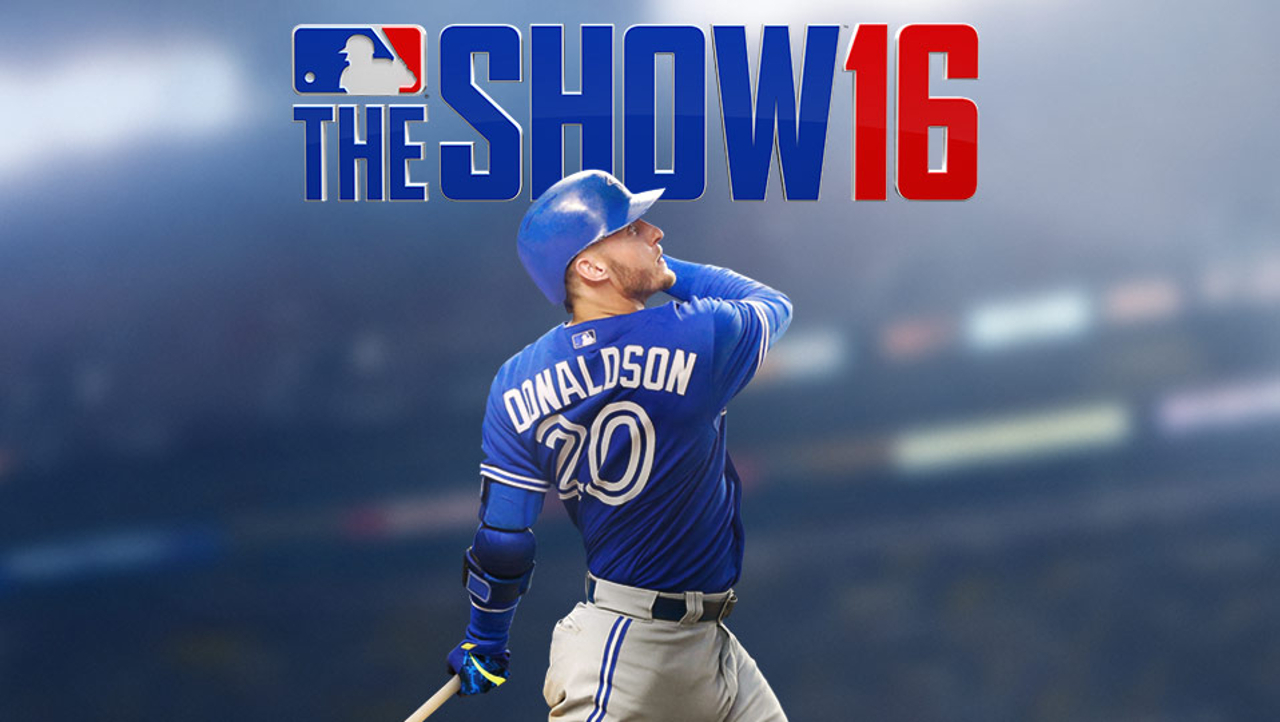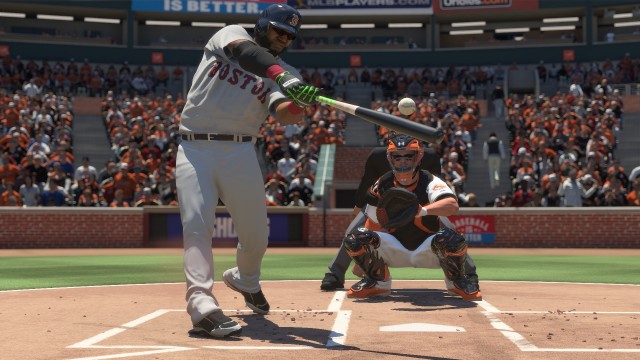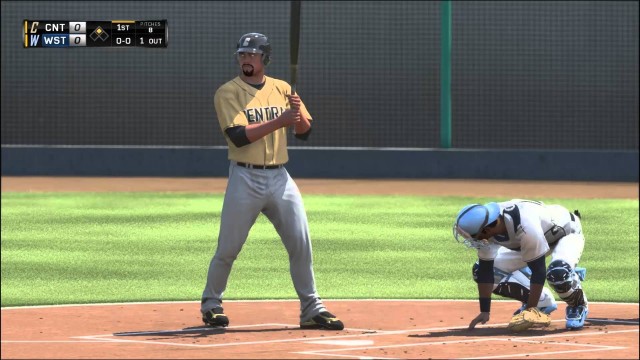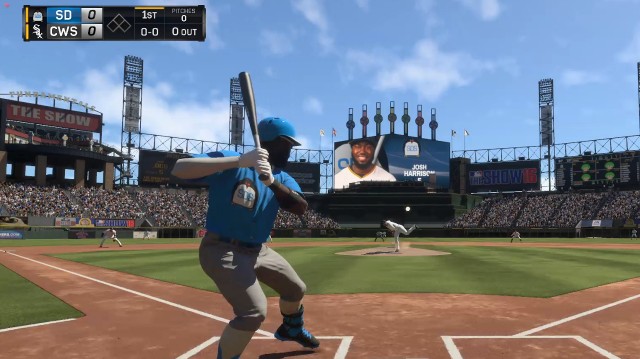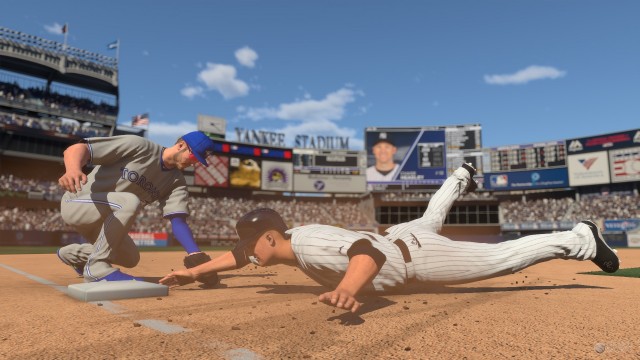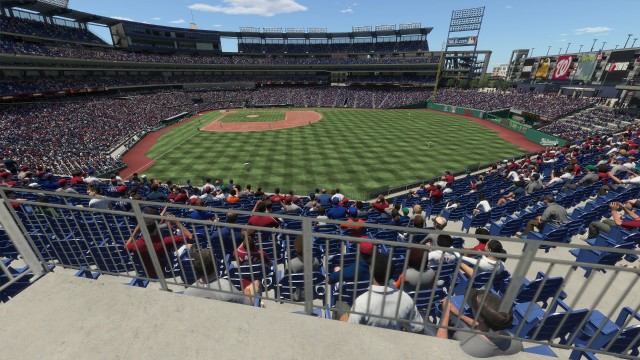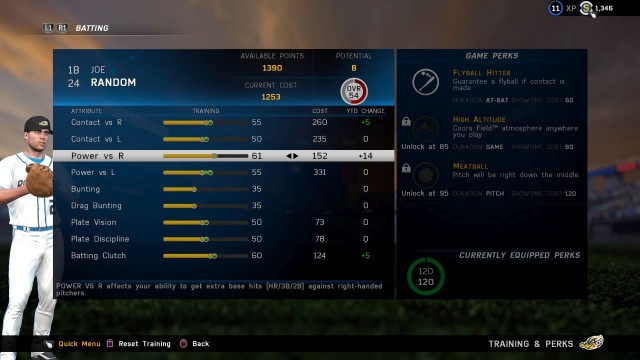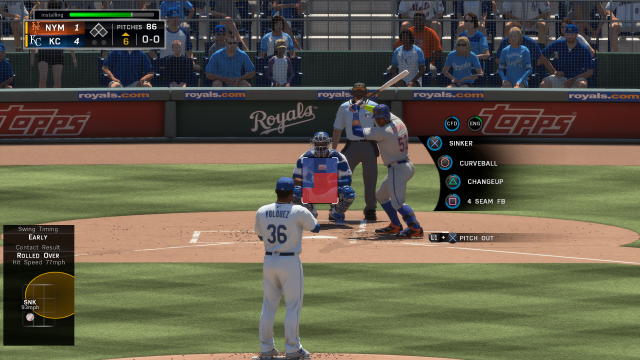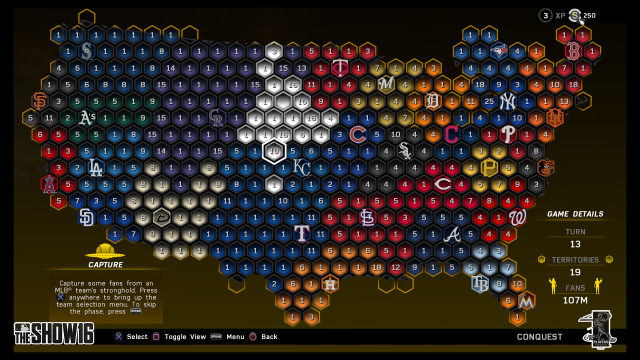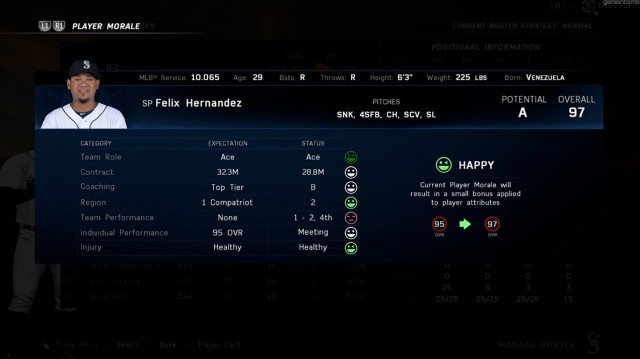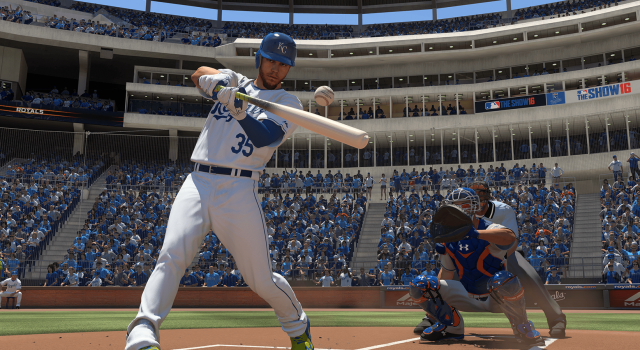MLB 15: The Show finally brought Sony’s standout series of baseball sims properly into the current console generation last year, boasting essential upgrades and highly appreciated new features that truly had the series on the cutting edge of sports games once again. Last year’s game wasn’t quite a true revolution, but it was a necessary refinement that finally took some much-needed steps forward. Predictably, that game and its smart tweaks are a pretty tough act to follow for this year’s offering, but MLB: The Show 16 (this game’s title has been slightly re-arranged, evidently), certainly puts in a valiant effort, and has no shortage of creativity when it comes to finding surprisingly neat new ways to mix up the great American pastime.
Rather than truly move the series forward though, MLB: The Show 16 takes a small step forward, and then mostly moves sideways. It’s still a superb baseball sim for enthusiasts of the sport that crave simply that, even considering that there are currently no other credible options for baseball sims beyond the PlayStation Nation, but as much as MLB: The Show 16 contains more surprises than its predecessor, it also feels like less essential of an upgrade than last year’s game. If you’re on a budget and still content with MLB 15: The Show, then you might be fine skipping MLB: The Show 16 this year, especially if you’re a hardcore purist of the sport, since the game’s new additions seem to be put in place to make the experience more accessible and arcade-like, rather than making it more deep and truly refined for the most devout of baseball enthusiasts.
PS Vita owners are completely left out in the cold regardless as well, since MLB: The Show 16 isn’t even bothering with a PS Vita port, and is simply releasing for PS4 and PS3. The fact that MLB 15: The Show’s PS Vita build was a $19.99 digital voucher in a plastic case might have considerably foreshadowed that though. Even so, the PS4 version feels like the only version of MLB: The Show 16 that truly matters at this point, since the PS3 version is once again phoning in its presentation and technical aspects, on account of Sony San Diego obviously maxing out the last-gen console’s capabilities at this point, and having nowhere else to push them as of around a couple of years ago.
If you’ve already conditioned yourself to buy each new installment of MLB: The Show on any given year, then MLB: The Show 16 won’t make you resent your purchase. Hell, even if you’re looking for some new, experimental ways to play the sport, MLB: The Show 16 is an especially creative offering that’s worth your consideration. It is nonetheless a game that’s relying more on gimmicks than real refinements though, making it a harder sell to less devout baseball fans who could care less about keeping up with every year’s MLB: The Show installment, and those who take the sport too seriously to enjoy the more light-hearted, casual-friendly new features.
On PS4, MLB: The Show 16 remains a gorgeous-looking, highly immersive sports sim. Most of its presentation is recycled from the PS4 build of MLB 15: The Show, but that’s alright, since MLB 15: The Show already represented the next level of visual refinement in baseball sims in its PS4 build from last year. Thus, as you can imagine, MLB: The Show 16 is still a great-looking game in its PS4 incarnation, and even adds in a few more lighting effects and environmental flourishes to add just a wee bit more realism to the many real-life MLB locales that you’ll play in. Any visual upgrades are small, but they’re still noticeable, especially when you can better appreciate PS4-exclusive effects like dynamic shadows and sunbeams, which look extra-realistic in MLB: The Show 16’s PS4 build.
Obviously, these tiny lighting and immersion boosts are not present in the PS3 build of MLB: The Show 16 though, which looks good enough, but pretty perfunctory. Frankly, while the PS3 version is mostly technically sound from a visual standpoint, even if it’s predictably more sluggish and a bit more tedious to navigate, it’s starting to look rather aged in contrast to its PS4 sibling at this point. Unless you’re on a very tight budget, you really should have upgraded to a PS4 by now, if you’re that serious about your baseball sims. MLB: The Show 16 is passable-looking enough for those who are still forced to play on a PS3, or still prefer to, but you’re probably better off saving the money that you would have spent on this game’s PS3 build (even if it is sold at a tempting $39.99 budget price for bargain hunters), and putting it towards a PS4 for a worthy experience, even if it means waiting an extra year for MLB: The Show 17.
Even on PS4 though, MLB: The Show 16’s character models feel just a bit less alive and dynamic, unfortunately, especially when a handful of them still look surprisingly poorly-rendered, even if most of them still look great. MLB 15: The Show had well-animated crowds and uniquely personalized players that all felt like individuals, furthering the feeling of actually playing a genuine MLB sports broadcast, and while this is still the case in many places in MLB: The Show 16, especially given the variable personality displays of the players, it does feel like a few more corners were cut with the character models in this year’s baseball sim. The crowds still react to whether the appropriate teams are winning or losing, but they all seem to use the same canned animation cycles now, making them feel less believable. Likewise, even the players start recycling the same selection of animations a bit more frequently than they did in last year’s game, or so it appears. The environments may have a bit of added immersion in MLB: The Show 16, but the personalities seem just a tad less… Personal. This means that MLB: The Show 16 is still a sharp-looking baseball game, but in terms of improving the presentation of MLB 15: The Show, it’s a bit of a wash.
MLB: The Show 16 more or less presents the same audio capabilities as MLB 15: The Show. Again, this is a good thing on paper, since MLB 15: The Show has sublime audio, and thus, so does MLB: The Show 16, but as with the visuals, there isn’t really much in the way of real leaps over the PS4 and PS3 builds of last year’s game. It’s still undeniably gripping and lifelike to play the game with a full-fledged home theatre system and surround speakers though, which fully immerses you in the baseball experience by realistically rendering the sounds of bat cracks, base slides and commentator exclamations, and even on regular TV speakers, MLB: The Show 16 still sounds incredibly realistic and credible in terms of sounding like the actual sport.
Once again, the regular commentators, Matt Vasgersian, Eric Karros and Steve Lyons return to provide game commentary in MLB: The Show 16, and they still sound fine, further helping the game replicate the feel of a real-life baseball broadcast. As with the player and crowd animations though, Vasgersian’s, Karros’ and Lyons’ commentary does repeat itself a tad more often in contrast to last year’s game, and that means that listening to them during your many rounds of batting, pitching and fielding is a bit less fun, even if they still do a reasonably good job of reacting dynamically to gameplay. Fortunately, if you ever do get annoyed with the commentators, you can turn them off, even individually, if just one of them happens to bug you for whatever reason.
When it comes down to it, MLB: The Show has pretty much already perfected its audio experience, so it stands to reason that MLB: The Show 16 is still presenting much of the same in terms of its acoustic flavouring, right down to the generic licensed hip-hop and rock tunes that play in the menus whenever you don’t load up your own custom music. On the bright side though, these games sound as sublime as they always have in this year’s offering, and the audio still does an excellent job at fully immersing you in a fully-licensed rendition of baseball, exactly as it’s presented on your television, and, if you have surround sound, as if you’re actually sitting in the bleachers, or playing on the field.
Since the MLB league in its entirety is cozily licensed out to Sony in the gaming medium, MLB: The Show is your one high-profile choice of fully-licensed baseball sims at this point. Still, this series has never failed to stand around the top of the heap of sports sims overall, and fortunately, much of that gameplay appeal is still maintained in MLB: The Show 16. The tight controls, offered in both beginner and expert renditions, continue to give you outstanding, responsive influence over the field, the bat and the pitcher’s hand, just as the clean, well-presented menus give you detailed, helpful outlines of all of the essential stats and figures that hardcore baseball enthusiasts would demand to know, even if the ability to press the Touch Pad to pull up certain statistics and skip through tutorials makes navigation a bit smoother in the PS4 version.
In terms of how MLB: The Show 16 fundamentally plays, there isn’t too much to say, because if you’ve played one MLB: The Show game, you’ve played virtually all of them. It’s baseball, and it plays exactly as baseball should in the modern era of gaming. The controls and navigation are mostly unchanged in MLB: The Show 16, though the camera view is actually a bit different when you’re at bat now, giving you a wider view of infielders that makes it easier to track low hits and pop flies. It also comes in handy on the rare occasion when the catcher misses the ball during a tricky pitch, since the camera can now follow the runaway ball easily with this new viewpoint, contrary to previous years’ installments.
The one major control change comes into play in the series’ fan-favourite solo mode, Road to the Show, which introduces a new hook called ‘Showtime’ in MLB: The Show 16. Using Showtime, players can press R2 to slow down time during pitches and field attempts, allowing them to make an extra-precise play, even down to the wire. It can also be very funny if you botch an attempt to use Showtime by missing a swing or a catch, which will show your epic failure in bullet time, and offers especially funny ways to make use of the Share Button to show your blunders to friends and the community, if you don’t mind laughing at yourself, and you’re playing the PS4 version. You only get limited uses of Showtime, which is governed by a meter that shows up around the button prompt on-screen to prevent you from abusing it, but either way, as cool as it can be, baseball purists will probably dislike the feature. You can opt to ignore Showtime if you want to keep your baseball experience fully grounded and realistic, since it can feel like cheating at its worst, but it can also serve as a great trump card if you’re on the losing side of a game, and want to demonstrate a stylized sense of athletic instinct.
Showtime isn’t the only new hook added to Road to the Show either, as players once again groom a teen hopeful into a major league all-star. The mode has been expanded and streamlined in MLB: The Show 16, and is probably the one mode that feels noticeably elevated from its more conservative incarnation in MLB 15: The Show. The most appreciated new addition to Road to the Show is the fact that you can now upgrade your custom player at your leisure during a game, and no longer have to constantly quit to the main menu to do so, which helps keep up the flow of play very nicely.
Likewise, you can opt to simulate and skip over any element of a ball game when you’re pressed for time, in an appreciated evolution of the Quick Counts idea that was introduced in last year’s game. Do you hate fielding and would rather purely focus on batting, for example? Well, go ahead and leave your fielding and dugout time in the hands of the A.I., who will have you back at your preferred mode in barely a few seconds! Obviously, die-hard baseball enthusiasts won’t want to give up this direct control over their player, since the A.I. won’t always play in your favour when you simulate play time, but for the more casual, impatient or otherwise pressed-for-time crowd, this elimination of menus, load times and barriers from the prior games’ Road to the Show modes is a godsend in MLB: The Show 16.
Of course, an especially fun incentive to keep directly playing Road to the Show games as much as you can, beyond the returning appeal of leveling up your custom player and outfitting them with stat-boosting licensed sporting equipment, RPG-style, is the introduction of Perks, a feature that Sony San Diego clearly borrowed from competitive games like Call of Duty. Applying Perks will diminish your available Showtime Meter, but they provide lots of unofficial ways to mess with the game and turn the tide, potentially forcibly shifting the game toward your player’s strengths when you need some good fortune.
You have to at least be drafted and level up a fair degree before you can use Perks in your games, with MLB: The Show 16 even adding in the true-to-life Bowman Scout Day for highly realistic evaluations in real-life drafting drills for batting and fielding, but once you get past the early portions of Road to the Show, you can let fly with all sorts of tricks, which the A.I. never gets to use. Of course, the ability to import your data from a console copy of MLB 15: The Show into MLB: The Show 16, so you can keep your custom player’s stats and legacy going this year, can also help you bypass these early barriers in Road to the Show, and get you right into the fun without needing to start all over again. Again though, bear in mind that players no longer affiliated with the MLB in 2016 can’t be carried over into MLB: The Show 16 though, for legal reasons.
Whether you’re starting out in Road to the Show or importing a custom player from MLB 15: The Show however, Perks come in both Consumable and Passive varieties that amusingly alter the game’s stakes, with Consumable Perks being activated and used up in a pinch, while Passive Perks are constantly in play throughout a game. Like Showtime, baseball purists will no doubt avoid Perks, since they disturb the realism, and blatantly give you an unfair advantage, but they can be fun to use for more laid-back players. Consumable Perks can do things like force a runner to steal a base for an easy out, or prevent the batting player from hitting any foul balls, making them ideal for a quick turnaround. Passive Perks meanwhile can do things like make it easier to hit home runs by altering the field dimensions, or automatically give you a One-Ball count when a new player goes to bat. The wide array of Perks in the game is actually pretty impressive, and if you don’t mind using them, there’s lots of ways for less particular players to give themselves a strategic edge, and make Road to the Show just a bit more fun.
Fantasy baseball-based Diamond Dynasty has also received a handful of new play modes in MLB: The Show 16, along with maintaining the ability for players to craft their own team icons, and amass baseball cards to outfit their perfect roster of baseball stars. The all-new Conquest Mode for example is a neat strategy-based mode where various teams vie for control of the U.S. (and Toronto), by sending out their count of fans between territories, and playing quick three-inning games against other teams that they run into. Depending on the results, you’ll win and lose fans, with the winning team being the one that eliminates all of the others, and amasses all of the fans in the country. Conquest is a mode that should be addictive fun for those who enjoy strategy games, but it’s pretty gimmicky, and most other players will probably turn their nose at it, especially since you can just simulate games if you can’t be bothered. It also doesn’t help that Conquest doesn’t explain itself very well, and those that aren’t well-versed in strategy games will probably be confused about how exactly you’re supposed to play it effectively.
The other major new mode added to Diamond Dynasty in MLB: The Show 16 is Battle Royale, a mode that pits you against other players across the PlayStation Network. This mode normally requires a 1,500 Stub buy-in (yes, the in-game currency, ‘Stubs’ are still in effect in MLB: The Show 16, and are used to pay for pretty much anything in the in-game economy), but the first time, it’s free to attempt. This mode basically challenges you to put together your best Diamond Dynasty team with a limited parameter of player potential (avoiding unfair advantages with your players and their skills), then take on the custom teams of other players in three-inning games. You’re allowed to lose one game, but after you lose two, you’re eliminated, and lose all of your winnings. Those who reach the twenty-win mark will net some great bonus cards for their Diamond Dynasty roster, and you can still get a decent bonus for nineteen wins if you only lose once, though you have to be pretty skilled at MLB: The Show to get anywhere in this mode. Still, for the most ultra-competitive players, Battle Royale could be even more thrilling than the game’s actual online multiplayer suite, especially with your accumulated winnings constantly on the line!
Of course, the major caveat to Diamond Dynasty from last year’s game is sadly still a big issue in MLB: The Show 16; Microtransactions. In fact, the microtransactions are arguably even worse in this year’s game, where they now range from $0.99 to a staggering $99.99 (!) worth of ‘free’ Stubs, and once again, the in-game economy is really slanted in favour of players who are willing to whip out their wallets and credit cards to buy whatever equipment and card boosters they want for their fictional teams. As with MLB 15: The Show, these microtransactions are really gross, and completely inexcusable, especially since the game now seems to want you to spend even more than last year’s game to get the best stuff, after you’ve already paid $59.99 USD/$79.99 CDN for your entry fee, in the case of the main PS4 version. Yuck!
Yes, it’s technically true that you can earn Stubs yourself just by playing in any game mode, but it still takes way too long to build up any worthy count of Stubs without paying for microtransactions, and this old-fashioned Stub-amassing won’t be an option for people that aren’t willing to quit their jobs and sequester themselves in their game room all day, every day. Even though there’s cool new additions in Diamond Dynasty like the opportunity to buy entire stadiums, or undertake challenges under specialized ‘MLB Captains’ like cover athlete, Josh Donaldson, it all comes back to Sony seemingly slanting the game in favour of making you pay more actual cash for more Stubs, simply so you can do anything in a timely fashion. This is most noticeable with Battle Royale’s troublesome buy-in necessity, which feels especially greedy on the part of Sony, and while it doesn’t take too long to raise 1,500 Stubs in-game, you have to do it every time you want to re-attempt Battle Royale without paying real money, which is a huge pain. Seriously, Sony, stop it with this microtransaction crap! You’re actively hurting the experience with these freemium elements that have no place in a triple-A game production that demands a triple-A entry fee!
Still, the efforts to make MLB: The Show 16 more personalized and strategic nonetheless lend themselves to creative and addictive gameplay for the right audience, in Diamond Dynasty and otherwise. Franchise Mode has also seen a tweak to this effect, with players now having to manage player morale for the first time, on top of the many other manager demands with the teams they oversee. If you don’t play a certain player for example, or even shuffle them in the batting line, their mood may change, which negatively impacts their performance. You can no longer just rely on raw data when managing your teams, and that does add an extra element of engagement to Franchise Mode. This is on top of worrying about the usual necessities of trading and managing injured players, and not being fired for doing a crappy job, obviously, but you can leave most of your decisions in the hands of the A.I. to make things a bit easier on you. Once again though, relying on the A.I. doesn’t always work in your favour, especially since giving the CPU too much control means that it will trade and disable players at its leisure, with no warning given to you! As usual, you get out of Franchise what you put into it, so strategy-minded players that are willing to put in the time will still find it to be a great mode overall in MLB: The Show 16.
The expected trappings like basic one-off exhibition matches against local friends or the CPU, one-off online matches against friends and random players on PlayStation Network, bonus modes like Postseason and Home Run Derby, and the chance to simply practice your fielding, pitching and batting play at your leisure, are naturally all present and accounted for in MLB: The Show 16, and none of them have seen any real changes from last year. This leaves MLB: The Show 16 packing no shortage of interesting ideas in its main modes like Road to the Show and Diamond Dynasty, though when it comes down to it, the gameplay didn’t pioneer anything quite so ingenious as the Quick Counts and stat carryover from MLB 15: The Show. MLB: The Show 16 offers some fun new ways to enjoy baseball, and the shift towards more arcade-style, light-hearted play is something that more laid-back players who don’t care about perfect realism in their gameplay will appreciate, but that doesn’t change the fact that MLB: The Show 16 ultimately presents diversions over refinements, if that matters to you and your budget.
MLB: The Show 16 maintains a lot of the best elements of last year’s game, so one could justifiably make the case that it’s still the best baseball sim on the market at present, by a hair, but even if last year’s offering still didn’t overhaul virtual baseball, the fact remains that MLB 15: The Show upgraded the series more noticeably than MLB: The Show 16 does. The additions to MLB: The Show 16 can be fun, and they’ll definitely entertain people who are looking for a different spin on a baseball sim, but there’s clearly an emphasis placed on gimmickry and surface sheen in this year’s game, and that may not be enough to sell it to people who have a distaste for buying every new MLB: The Show entry each year.
Like I said, if paying for a new MLB: The Show game annually like clockwork doesn’t bother you, then MLB: The Show 16 will satisfy you. It will probably even tickle and entertain you in plenty of surprising respects, compared to the more straight-laced rendition of the sport from last year! As with many of the more recent MLB: The Show games though, MLB: The Show 16 won’t truly wow you. It’s a well-designed, creative and plenty enjoyable baseball sim, but it still exists firmly within the realm of what this series reliably delivers every year, without really going off-book in terms of the fundamentals.
So, the question remains; If you love baseball, and you own a current PlayStation console (preferably a PS4), should you purchase MLB: The Show 16? Well, it depends. If you play these games for simple fun, and enjoy creative and interesting new challenges in a sport as only video games can provide, then buy MLB: The Show 16 and have a great time with it, because that’s where its strengths lie. If you’re more budget-conscious and are more concerned with big strides in your sports sims though, you may want to skip this year, especially since a lot of this game’s better ideas will probably be brought to the table again in MLB: The Show 17 next year. I suppose, if you were to put it in baseball terms, MLB: The Show 16 isn’t a home run, but it’s a worthy hit, especially if you’re not keeping score.

